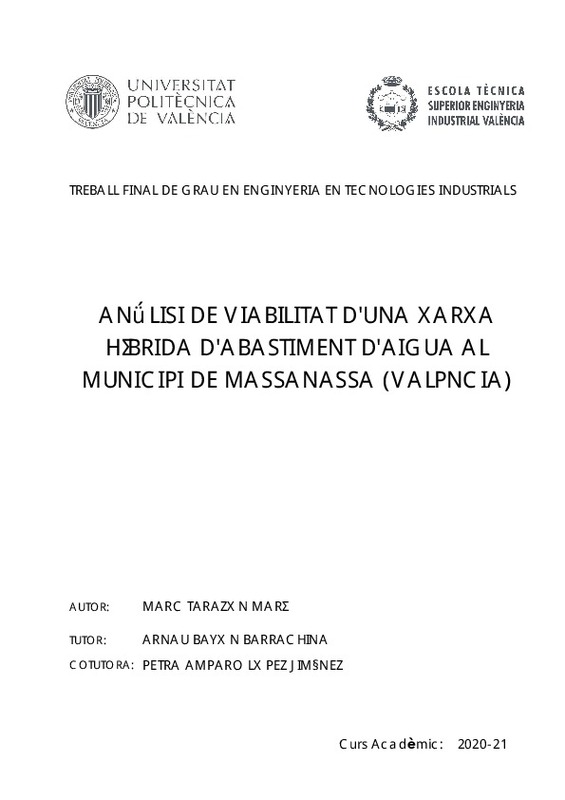|
Resumen:
|
[ES] Amb aquest treball es pretén fer una anàlisi de viabilitat d'una xarxa d'abastiment d'aigua potable per al municipi de Massanassa, un municipi al sud de València de 9500 habitants. L'anàlisi ve motivat per fer un ús ...[+]
[ES] Amb aquest treball es pretén fer una anàlisi de viabilitat d'una xarxa d'abastiment d'aigua potable per al municipi de Massanassa, un municipi al sud de València de 9500 habitants. L'anàlisi ve motivat per fer un ús diferenciat de dos tipus d'aigües amb què compta el municipi.
En l'actualitat, el municipi obté el seu abastiment de dos fonts: un aqüífer i la depuradora de Picassent. L'aigua de l'aqüífer presenta uns nivells de nitrats i nitrits que no la fan apta per al seu ús. Aquesta aigua és tractada i posteriorment mesclada amb l'aigua provinent de la depuradora de Picassent, que l'Ajuntament compra a l'EMSHI. L'aspecte diferencial de la proposta radica en no fer aquesta mescla i que cadascuna d'aquestes aigües s'utilitze per a usos distints, circulant per xarxes independents, però que discorren de manera paral·lela i és un projecte que l'Ajuntament de Massanassa, entitat encarregada del subministrament d'aigua, es planteja des de fa temps.
Per tal de modelar la xarxa s'utilitzaran plànols d'Autocad, les dades d'abastiment, així com altra informació complementària per definir els diferents paràmetres del model. La informació ha sigut subministrada per l'Ajuntament de Massanassa. Amb tot, es traslladarà la informació dels plànols a un model d'EPANET i caracteritzarà cadascun dels seus diferents elements. Així, s'obtindrà un model on estudiar els diferents paràmetres com cabals en els punts de consum, pèrdues de càrrega i pressions de servei, amb la fi de comprovar la viabilitat d'una xarxa com la que es proposa.
Per acabar, es compararà la viabilitat econòmica del projecte, la seva instal·lació i posada en funcionament, comparant-la amb el sistema actual. D'aquesta manera, s'obtindrà una idea aproximada que permetrà a l'Ajuntament prendre una decisió respecte a l'execució o no del projecte, tot i tenint en compte altre tipus de consideracions i motivacions més enllà de l'econòmica, com l'augment del consum de l'aigua embotellada si no es prenen mesures com aquesta per a la millora de la qualitat organolèptica de l'aigua de boca.
[-]
[EN] The aim of this work is to make a feasibility analysis of a drinking water supply network for the municipality of Massanassa, a municipality south of Valencia with 9500 inhabitants. The analysis is motivated by making ...[+]
[EN] The aim of this work is to make a feasibility analysis of a drinking water supply network for the municipality of Massanassa, a municipality south of Valencia with 9500 inhabitants. The analysis is motivated by making a differentiated use of two types of water available to the municipality.
At present, the municipality obtains its water supply from two sources: an aquifer and the Picassent water treatment plant. The water from the aquifer has levels of nitrates and nitrites that make it unfit for use. This water is then treated and mixed with water from the Picassent treatment plant, which the city council buys from EMSHI. The differential aspect of the proposal lies in not making this mixture and that each of these waters is used for different uses, circulating through separate networks, but running in parallel and is a project that the City Council of Massanassa, the entity responsible for water supply, has been considering for some time.
In order to model the network, AutoCAD plans, supply data and other complementary information will be used to define different parameters of the model. The information has been provided by the Massanassa City Council. The information from the plans will be transferred to an EPANET model and each of its different elements will be characterized. Thus, a model will be obtained with which to study different parameters such as flow at the points of consumption, head losses and service pressures, in order to check the feasibility of a network such as the one proposed.
Finally, the economic feasibility of the project, its installation and commissioning will be compared with the current system. In this way, an approximate idea will be obtained that will allow the City Council to make a decision regarding the execution or not of the project, as well as taking into account considerations and motivations beyond the economic one, such as the increase in the consumption of bottled water if measures are not taken to improve the organoleptic quality of the water in the mouth.
[-]
|







